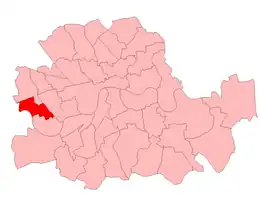| Barons Court | |
|---|---|
| Former borough constituency for the House of Commons | |
| County | 1955–1965: County of London 1965–1974: Greater London |
| Borough | London Borough of Hammersmith |
| 1955–1974 | |
| Seats | 1 |
| Created from | Hammersmith South, Fulham West and Fulham East |
| Replaced by | Fulham and Hammersmith North |
Barons Court was a constituency of the House of Commons of the Parliament of the United Kingdom from 1955 to 1974. It was represented by one Member of Parliament (MP), elected by the first-past-the-post system of election.
Boundaries

Barons Court was a borough constituency of the parliamentary County of London. It was created from parts of three abolished constituencies in 1955: the bulk of Hammersmith South and parts of Fulham West and Fulham East. It was composed of the northern end of the Metropolitan Borough of Fulham (Barons Court, Margravine, and Lillie wards) and the southern section of the Metropolitan Borough of Hammersmith (Broadway, Brook Green, Grove, and Ravenscourt wards). It did not include the whole of either Metropolitan Borough.[1]
When local government in London was reformed in 1965, the area became part of the London Borough of Hammersmith in Greater London. This did not affect the parliamentary boundaries until 1974. In that year constituencies were redrawn to correspond to wards of the London Borough: the Barons Court constituency was divided between the seats of Fulham and Hammersmith North.
Members of Parliament
| Election | Member [2] | Party | |
|---|---|---|---|
| 1955 | Thomas Williams | Labour | |
| 1959 | Compton Carr | Conservative | |
| 1964 | Ivor Richard | Labour | |
| 1974 | constituency abolished | ||
Elections
Elections in the 1950s
| Party | Candidate | Votes | % | ±% | |
|---|---|---|---|---|---|
| Labour Co-op | Thomas Williams | 20,748 | 50.2 | ||
| Conservative | Keith Joseph | 20,623 | 49.8 | ||
| Majority | 125 | 0.4 | |||
| Turnout | 41,371 | 75.8 | |||
| Labour Co-op win (new seat) | |||||
| Party | Candidate | Votes | % | ±% | |
|---|---|---|---|---|---|
| Conservative | Bill Carr | 18,658 | 48.9 | −0.9 | |
| Labour Co-op | Thomas Williams | 17,745 | 46.5 | −3.7 | |
| Independent Liberal | Simon Harold John Arthur Knott | 1,766 | 4.6 | New | |
| Majority | 913 | 2.4 | N/A | ||
| Turnout | 38,169 | 76.3 | +0.5 | ||
| Conservative gain from Labour | Swing | +1.3 | |||
Elections in the 1960s
| Party | Candidate | Votes | % | ±% | |
|---|---|---|---|---|---|
| Labour | Ivor Richard | 15,966 | 47.5 | +1.0 | |
| Conservative | Bill Carr | 14,800 | 44.1 | −4.8 | |
| Liberal | Simon Harold John Arthur Knott | 2,821 | 8.4 | New | |
| Majority | 1,166 | 3.4 | N/A | ||
| Turnout | 33,587 | 72.9 | −3.4 | ||
| Labour gain from Conservative | Swing | +2.9 | |||
| Party | Candidate | Votes | % | ±% | |
|---|---|---|---|---|---|
| Labour | Ivor Richard | 17,021 | 51.7 | +4.2 | |
| Conservative | Bill Carr | 13,551 | 41.1 | −3.0 | |
| Liberal | Simon Harold John Arthur Knott | 2,384 | 7.2 | −1.2 | |
| Majority | 3,470 | 10.6 | +7.2 | ||
| Turnout | 32,956 | 75.2 | +2.3 | ||
| Labour hold | Swing | ||||
Elections in the 1970s
| Party | Candidate | Votes | % | ±% | |
|---|---|---|---|---|---|
| Labour | Ivor Richard | 13,374 | 48.0 | −3.7 | |
| Conservative | Robert E. Brum | 12,269 | 44.1 | +3.0 | |
| Liberal | Simon Harold John Arthur Knott | 2,206 | 7.9 | +0.7 | |
| Majority | 1,105 | 3.9 | −6.7 | ||
| Turnout | 27,849 | 67.3 | −7.9 | ||
| Labour hold | Swing | ||||
See also
References
- ↑ F A Youngs Jr., Guide to the Local Administrative Units of England, Vol I: Southern England, London, 1979
- ↑ Leigh Rayment's Historical List of MPs – Constituencies beginning with "B" (part 1)
Sources
- Boundaries of Parliamentary Constituencies 1885-1972, compiled and edited by F.W.S. Craig (Parliamentary Reference Publications 1972)
- British Parliamentary Election Results 1950-1973, compiled and edited by F.W.S. Craig (Parliamentary Research Services 1983)
- Who's Who of British Members of Parliament, Volume IV 1945-1979, edited by M. Stenton and S. Lees (Harvester Press 1981)